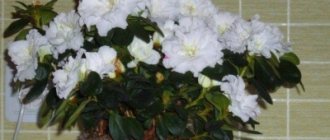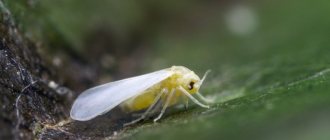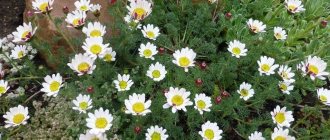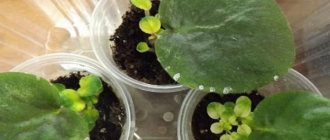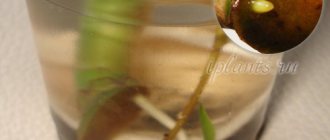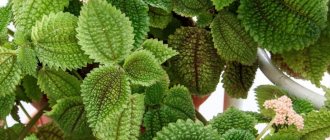Petunias grow on my balcony all summer, but in winter the boxes are empty. One friend advised planting heather in them in the fall - they say it will stick out with colorful caps all winter, decorating the balcony. I didn’t doubt it for a long time; that same year I planted four varieties at once. And they all withered away happily.
I don’t like to leave things halfway, and if something doesn’t work out, I rush to figure out what went wrong. I went to the garden center for a consultation. It turned out that the soil in which the petunias grew and which I carefully fed with mineral water after them was not suitable for the heather. Since on the one hand it is an unpretentious flower, but on the other hand, if the soil was chosen incorrectly, you will not get beauty from the semi-shrubs.
Description
Only one species belongs to the genus Heather - Common Heather.
But the number of very decorative varieties reaches 300 and continues to increase thanks to the efforts of breeders, which indicates the great popularity of this amazing plant. Heather is often confused with the charming representative of the numerous Heather genus (Ericaceae) - Erica, but despite all the external similarities they have noticeable differences.
This shrub has always been a legendary plant in the cultures of many countries. In Norway it is the national flower.
According to Scottish legend, when God distributed plants throughout the earth, only Heather agreed to live on their poor, windswept soil. For which he was awarded special endurance, exquisite beauty and amazing durability.
An evergreen, fast-growing shrub that can be creeping or highly branched. It has very decorative foliage in various shades of green (from light green to silver gray). Some varieties have foliage that is red, orange, bronze, or gold. The leaves are small, whorled, narrow, oblong (0.5-2 cm), triangular, sometimes pubescent. They give the shrub a special modest charm. But when the Heather blooms, it becomes a bright star and a decoration of the house or garden for a long time.
Small, barrel-shaped bells are formed by four to five simple or partially fused petals of incredible colors. Even Heathers with double and super-double flowers have been bred, as if strewn with small fragrant roses. They almost completely cover the bush, turning it into a blooming outbreak. Small flowers are collected in lush pyramidal or round paniculate inflorescences.
The flavonoids, arbutin, and resins contained in the plant make it indispensable in medicine in the treatment of a huge number of diseases. The leaves are also used to make dye for the fabrics of the famous Scottish kilts and rugs.
Heather has a delicate aroma and is an excellent honey plant.
3. Varieties and types of heather:
3.1. Tree heather - Erika arborea
Large and abundantly flowering shrubs or even low trees with a dense, spreading crown up to 3.5 m high. The leaves are narrow, needle-shaped, green, reminiscent of pine needles and reach a length of 5 - 7 mm. The flowers are fragrant, bell-shaped, white or pink with a dark center, collected in large inflorescences. The flowering is very abundant - the buds that appear can completely hide both the leaves and branches.
↑ Up,
3.2.Common heather - Calluna vulgaris
A low-growing spreading shrub is a perennial with thin, profusely branched at the base, erect or creeping shoots, densely covered with oblong leaves. The leaves are green, often adjacent to the branches, arranged in opposite pairs. During the fall months, the leaves may take on a reddish, burgundy or bronze tint. In the second half of summer, the plant forms flowers, located mainly in the upper part of the stems. Flowers can be colored pink, lilac or red.
↑ Up,
3.3.Slender heather - Erica gracilis
Spectacular, profusely flowering bush heather up to 75 cm high with numerous thin shoots branched at the base. The leaves are needle-shaped, green or bluish-green, adjacent to the branches. The flowers are small but numerous, often located along the entire length of the shoots and completely hide the foliage. Flower colors include bright pink, lilac, white, and salmon.
↑ Up,
3.4.Common heather Dark Beauty - Calluna vulgaris Dark Beauty
A magnificent miniature variety of dwarf heather with very bright, raspberry-pink flowers and erect or creeping. These low-growing bushes do not exceed 20 cm in height. The leaves are dark green, small, and resemble scales. The flowering period begins at the end of summer and lasts until October, after which the flower stems should be trimmed.
↑ Up,
3.5.Heather Annabel - Calluna Annabel
Tall plants reaching 45 - 60 cm in height. The flowers are lilac, densely covering plant stems, and are often used for cutting. Flowering occurs in September - October.
↑ Up,
3.6.Common heather Aphrodite - Calluna vulgaris Aphrodite
An evergreen shrub with dark green leaves 40–60 cm high. The buds are soft pink and do not open completely. The flowering period is very long and when grown in open ground it lasts from August until serious frosts.
↑ Up,
Growing
In nature and gardens, Heather blooms from June to August, but at home, flowering may shift to October-March. Withered flowers dry out without losing color, and remain on the plant for several months, maintaining its high decorative value. Therefore, they can not be cut for a couple of months. But if dried flowers are removed, other branches will grow and bloom more abundantly.
Heather is an unpretentious plant. There are some features of its cultivation that need to be taken into account, then it will delight you with its flowering for many years. After all, Heather lives up to 30 years.
In a temperate climate, for the summer the bushes can be moved to the balcony, even to a sunny place, not forgetting about frequent watering and spraying.
For more luxuriant branching and flowering, branches are pinched. After flowering ends, the bush is subjected to formative pruning.
Reproduction is possible in a greenhouse or greenhouse. Seeds and cuttings take root well, but flowering occurs in 3–5 years. Therefore, it is easier to purchase an already mature plant at the beginning of flowering.
Medicinal properties of the plant
Traditional healers use heather or Calluna vulgaris (Latin name) as a medicinal plant.
The following diseases are treated with the help of decoctions and infusions:
- Kidney diseases – cystitis, pyelitis, urethritis;
- Infectious – dysentery, enterocolitis, tuberculosis, tonsillitis;
- Gastric – gastritis, increased acidity;
- Liver – cholecystitis;
- Cardiovascular – atherosclerosis;
- Diseases of the musculoskeletal system – rheumatism, gout, radiculitis;
- Skin diseases - burns, wounds, eczema, problems with poor hair growth associated with the condition of the scalp;
- Diseases of the nervous system – as a natural sedative, sleeping pill;
Heather contains microelements in its flowers and stems - phosphorus, calcium, sodium and potassium. The plant also contains useful organic acids and flavonoids.
It has the following properties:
- Antibacterial;
- Heals wounds;
- Relieves inflammation;
- Promotes expectoration;
- Increases sweating;
- Strong diuretic;
- Has a sedative effect;
Decoctions of the plant are taken orally for diseases associated with the gastrointestinal tract, liver, and cardiovascular system. During a sore throat, gargle with this decoction. The crushed dry powder is used for skin diseases. They alleviate the condition of tuberculosis with the help of an alcoholic infusion of heather. To help with diseases of the musculoskeletal system, take baths with a decoction.
First steps after purchase
When purchasing such a beautiful plant as Heather, you should pay attention to the condition of the branches and flowers. The fact is that a bush can die from even short-term drying out of the soil during transportation. This will not affect the appearance at all. It does not lose its decorative effect for months and stands perfectly as a dried flower. But I still want to get this treasure alive. Therefore, you need to check the condition of the plant before purchasing it. The branches should be flexible, alive, and the flowers should not fall off.
Having brought Heather into the house, it is worth giving it a short cool shower, which will wash away possible pests (especially spider mites) and have a beneficial effect on the plant. Immediately place the pot with the plant on a tray with wet peat or pebbles.
Possible difficulties
The bush grows slowly
Reason: 1) excess nitrogen in the soil, 2) inappropriate soil acidity.
Branches and flowers dry
Reason: 1) non-compliance with the irrigation regime and overdrying of the soil, 2) excessive dryness of the air, 3) insufficient acidity of the soil.
The leaves turned brown and the young shoots withered
Reason: 1) waterlogging and stagnation of water in the soil, 2) excess nutrients.
A grayish-white coating appeared on the leaves
Reason: 1) powdery mildew.
Subscribe and receive descriptions of new species and varieties in the “ornamental trees and shrubs” section by email!
Secrets of success
For Heather, acidic (pH 4.5–5.5) not very nutritious, but loose soil is suitable, which should be constantly moist, but without soaking. It is very important to have good drainage, otherwise the plant may quickly die.
The plant should be watered and sprayed frequently with well-settled soft water at room temperature. During the dormant period, watering is reduced and fertilizing is not done at all.
During the growing season and flowering, the plant responds well to fertilizing with organic fertilizers once a month. At the beginning of spring you need to replant it and feed it once with full mineral fertilizer.
Very interesting is the symbiosis of Heather with some types of soil fungi, which help it absorb nutrients and enrich the soil. The result is heather soil, which can later be used for planting Hydrangeas, Azaleas and plants that prefer acidic soils.
Heather loves cool rooms, fresh air and lots of sunlight. Keeping it at low temperatures of +7–12°C in winter and up to +20–24°C in summer will not allow Heather to die. It does not tolerate even short-term overdrying of the soil and hot, dry air. Frequent spraying will do him good.
Let's summarize
- Calluna is the Latin name for heather. This decorative shrub is represented by 300 varieties with different shades of leaves and fragrant flowers.
- The plant can be grown in an apartment. It needs to be watered regularly, kept in moist air, and pinched in the spring.
- But of course, more often heather is planted in flower beds. The creeping plant quickly forms a colorful carpet. It is important that the soil under the crop is acidic.
And you will learn about the most popular varieties of calluna and why it does not always take root in the garden or balcony box from this video:
Landing in the ground
When growing common heather, it is necessary to create exactly the same conditions as in its native habitat.
The soil must be acidic; it is advisable to use a semi-shaded area, because the plant does not like direct sunlight, especially for a long time.
The soil should be loose and easily allow moisture to pass through. The plant needs regular and abundant watering, especially young plants that have just begun to develop.
Despite the fact that the plant itself grows throughout Europe, including in cold regions, some varieties require additional shelter during the winter season. As a rule, such shelters are constructed from spruce branches; it retains heat well and prevents excess moisture from penetrating inside.
Peculiarities
The plant has an unremarkable appearance most of the time; its flowering begins only in July or August, during which time the bush changes greatly.
Shrubs planted at equal distances from each other during the flowering period will turn any area into a beautiful garden. Considering the large number of varieties of shades of leaf blades, from different types you can create full-fledged flower beds in the garden.
At the end of flowering, the leaves dry out, but do not fall off for about a month after drying. Varieties of heather grow virtually throughout Europe; they are found even in Siberia, which allows us to conclude that this plant is resistant to frost and sudden temperature changes.
Heather has a large number of varieties in shades, but there is only one species of heather in the family. In addition, it includes Erica, Andromeda and others.
Application in landscape design
Due to the wide variety of shades, common heather is very often used in landscape design. With the help of this amazing shrub, perennial flower beds are formed, which are very easy to care for.
In addition, due to their lushness and growth, they can be used as a zoning element, with which you can divide the garden into several functional areas.
Shrubs can be used as a small living fence; they combine very effectively with full-size trees, forming a harmonious union, creating an aesthetic appearance of the site. Heather can grow into a continuous flowering carpet, which is often used to populate an entire area with beautiful flowers.
